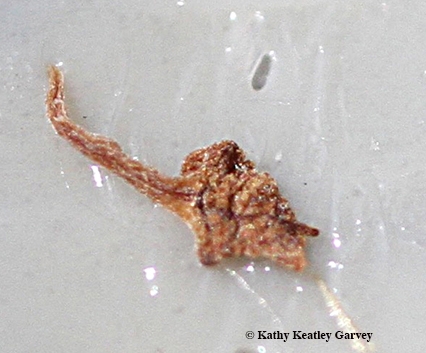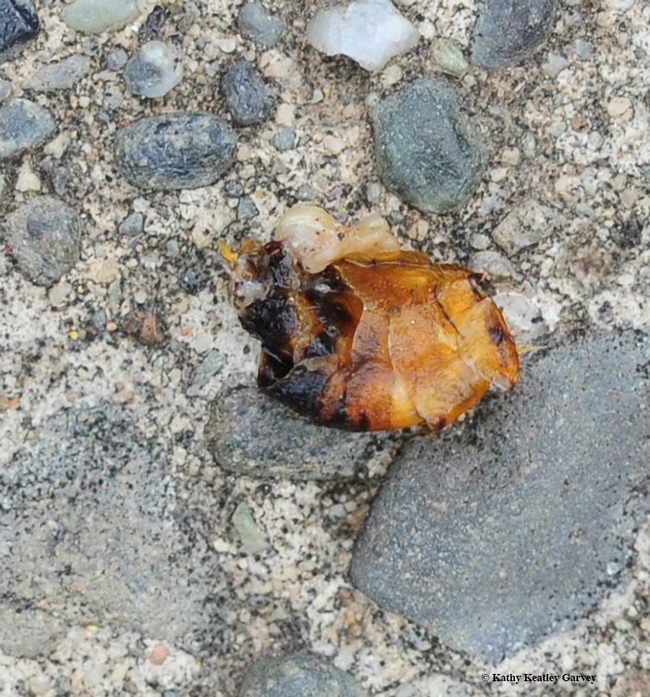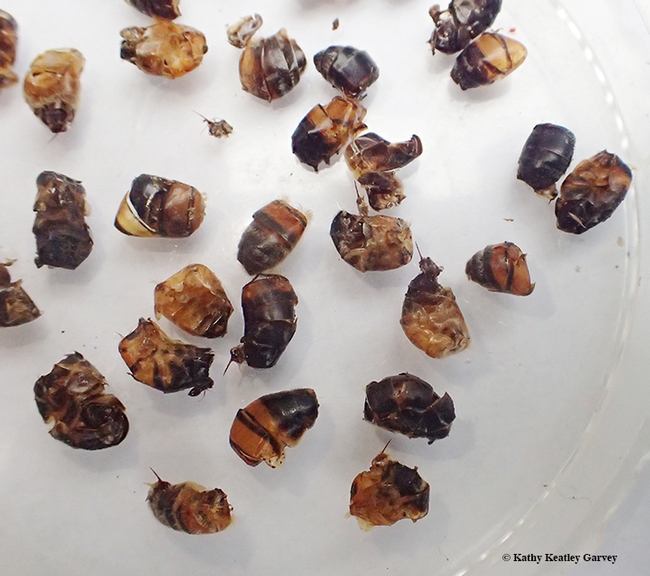
Here's the scenario: Our pollinator garden is buzzing with the sights and sounds of honey bees. Ah, spring! A few feet away, California scrub jays are nesting in the cherry laurel hedges. They leave periodically to gather food for their young. Dozens of honey bees are foraging in the Spanish lavender. They leave periodically to deliver nectar and pollen to their colonies.
It's Saturday, April 22, and I leave to cover the 103rd UC Davis Picnic Day. I am unaware that the scrub jays are having a picnic of their own in our Spanish lavender.
Scrub jays (Aphelocoma californica) eat bees. Honey bees. And lots of other insects, too, plus frogs, lizards, grains, nuts, fruits and vegetables. And yes, they will raid bird nests, eating the eggs AND the young.
But back to the bees. Our resident scrub jays seem to like our tenant honey bees a lot more than they should! We've seen them pick off a foraging bee, thrash it on the sidewalk, and decapitate it, leaving behind the bee abdomen (complete with stinger).
Scrub jays are intelligent. Never denigrate a scrub jay by calling it a "bird brain."
But what happened in our pollinator garden Saturday afternoon was totally unexpected.
Yours truly, shoeless but not sockless, walks out the back door and into the pollinator garden. I pad past the year-around bird feeder filled with seeds. (Our birds never go hungry!) I walk along the cement sidewalk separating the pollinator garden from the bed of Spanish lavender. And then...Ouch! What was that? Intense pain shoots up my foot. Feels like a barbed hook. A venomous barbed hook.
Bee sting!
When that happens, it's important to remove the stinger (apiculturists call it a "sting") or the venom will keep pumping. We do and it doesn't.
Then, being the curious sort, I walk back to the sidewalk--this time wearing shoes!--and see dozens of headless bees. A veritable carnage. I pick one up for closer investigation, and I get stung again. On my hand. By a dead bee.
What are the odds? Well, it happens. Dead bees can sting.
“As you are aware, the nervous system of insects is quite a bit more decentralized than is our own,” says UC Cooperative Extension apiculturist emeritus Eric Mussen, who completed 38 years of service in 2014 but continues to maintain an office in the UC Davis Department of Entomology and Nematology
“A honey bee sting, even when detached from the bee body--particularly the brain, from a mammalian point of view--can continue to operate: dig the sting in deeper and pump in the venom,” he says. "So, the still fresh and functional abdomens of decapitated honey bees can function just as they do when ripped from the body by stinging. It doesn't matter how the sting gets into your tissue, the exoskeleton, muscles, nerve ganglion, and venom sac act just like they would from a real sting. The trick, in your case, was to step on the abdomen at the perfect angle to push the sting into your skin. From then on, nature took over."
"Have I heard of people being stung by excised bee stings before?" Mussen asks. "No, I haven't, but it makes perfect sense to me that it happened."
The next day, I walk into the yard, and I see and photograph a scrub jay decapitating a bee, discarding the abdomen. It has apparently learned not to mess with the business end of a bee.
As for me, I have learned not to go shoeless in the pollinator garden...or I may get the business end of a dead bee.
Attached Images:

A California scrub jay nails a honey bee. (Photo by Kathy Keatley Garvey)

The California scrub jay decapitates the honey bee, avoiding the abdomen with the stinger. (Photo by Kathy Keatley Garvey)

This is what was left of the honey bee from the photos above. (Photo by Kathy Keatley Garvey)

On UC Davis Picnic Day, scrub jays had a picnic of their own in the author's yard, decapitating honey bees, and leaving behind the abdomens. Note the stingers. (Photo by Kathy Keatley Garvey)